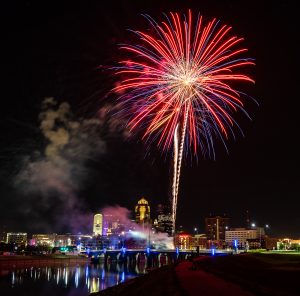The 4th of July is tomorrow and that means it’s fireworks time. During this crazy year of 2020 many fireworks shows have been cancelled, but not all of them have. So if you fortunate enough to have a show still going on its time to break out the camera for some fireworks photography.

When packing up the car with snacks, drinks, chairs, bug repellent and blankets be sure to have the following camera gear along.
- Camera
- Remote control trigger (cabled or wireless)
- Zoom lens
- Tripod
Anything to do before the show? You bet. Scout the location. Best to know what you are getting into, where they shoot the fireworks from, what the background will be like. How big will the display be? How long will it go for? Most fireworks displays are over in a half hour or less, and if you are stumbling around in the crowd looking for a spot and trying to set up in the dark, you’ll just be starting to make decent exposures as they light up the sky with the crescendo and say goodnight until next year.
Go scout. Get your spot. Get there early. Like, be the first car in the parking lot if at all possible. Get setup and get comfortable. Now that your situated its time to get the camera ready.
Capturing the action:

Now that you’re prepped and ready its time to frame up the shot for your fireworks photography session. First, when I shoot fireworks, I always get my frame, plus about 20%. I can always tighten up, but I want to give those fireworks room to play up there in the heavens. Frame too tight, you’ll have tracer lines of color going right out of the upper part of your picture, creating lines of interest that will pull your viewer’s eye right out with them. Next, place your camera on a tripod. Since you’ll be taking mutisecond exposures a sturdy tripod is a must.
After framing and getting the camera on the tripod, focus. As long as its daylight out focus on a point far from your location with auto focus. You should be out towards infinity as you don’t want to be right up under the fireworks. Once you’re focused switch the lens to manual. You don’t want your camera trying to auto focus when the action is taking place. To ensure you stay focused through the evening place a piece of gaffers tape on the focus ring to lock it in place. Also if you have vibration control on your lens be sure to turn it off. It’s not required when on a tripod and if its left on it will cause distortion in the photos. Also be sure to disable long exposure noise reduction on the camera if your camera has that feature.
Now for the camera settings. For aperture F8 is a reasonable starting point. Some photogs I know go even lower on the aperture scale, down to f11 or even f16. I personally like hanging in the f11 to f13 range. Over time, you will find which settings work for you.
ISO I tend to keep low. In the 100 to 200 range. You’re going to be doing shots that are multiple seconds in length so even in low light the fireworks and other light sources will illuminate your foreground subject if you have one.
For shutter speed you have several options here. One option is to set the camera to bulb mode. If you do this a cable release or a remote trigger is required as you don’t want to hold the shutter down on the camera itself. This will introduce camera shake and it will distort your photos.

Some shooters time the launch of the rockets and open the shutter accordingly, keeping it open for, say, 8-10 seconds, then closing down. This ensures
that they will record the path of the pyrotechnic into the night sky, and its explosion. This is a fine approach and is the one I usually do. Give it a try.
Others use a black card. A black card is just that, a black card. Nothing mysterious or fancy. It can be a piece of black cardboard, or foam core board. Or it can just be an index card covered with black tape. (Be sure it is not shiny tape. That might pick up slivers of light and reflect it back into the lens. Use a matte black type of photo tape, such as gaffers tape.)
With a black card, you can keep your shutter open for very lengthy periods and record multiple starbursts. You open the shutter, and shoot one explosion, then cover the lens with the card, and wait for the next. Experiment with this trick, and you’ll produce really terrific results, layering multiple fireworks into one picture.
Pro Tips
Be sure to capture fireworks at the start of the show. As the display goes on smoke will fill the sky. The first fireworks are always the clearest. Aso, if at all possible, be sure to position yourself so the wind is blowing the smoke away from you. Most any other directoin than right towards you is the best, so pay attention to the wind when choosing your spot.
Fireworks photography is fun so get out this year and do it, while maintaining a safe social distance of course! Get out, stay safe, and most importantly have fun this 4th of July weekend.